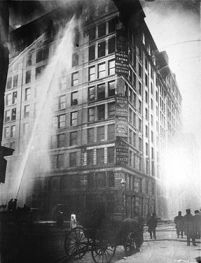 One of the worst factory accidents in the history of the United States – the Triangle Shirtwaist Factory fire – occurred 103 years ago today. Even today, despite the existence of OSHA and other safety regulations, factory jobs continue to expose workers to dangerous conditions. The many hazards surrounding the work place can lead to injuries that force workers to take time off or receive expensive medical treatments.
One of the worst factory accidents in the history of the United States – the Triangle Shirtwaist Factory fire – occurred 103 years ago today. Even today, despite the existence of OSHA and other safety regulations, factory jobs continue to expose workers to dangerous conditions. The many hazards surrounding the work place can lead to injuries that force workers to take time off or receive expensive medical treatments.
Overexertion
Overexertion can occur after frequent heavy lifting and spending long periods of time on your feet and moving. Many factory jobs are highly physical and workers can easily put too much stress on their bodies. In fact, in 2011, approximately 3.3 million Americans visited the emergency room due to overexertion injuries. Here in Georgia, overexertion is further complicated by high temperatures during the summer months. Last summer, a worker at a Georgia auto factory died after working in high temperatures on a welding line.
Repetitive Motion Injuries
This type of injury stems from doing the same movement over and over again, such as repeatedly bending over or pulling a lever. Those working in an automotive manufacturing plant are at risk of this injury, especially if they are working on the assembly line. In Georgia, meat packing factories are some of the most dangerous places to work, requiring repeated motions, sharp cutting instruments and the stress of keeping up with conveyors. Repetitive motion injuries can cause permanent damage if not treated promptly.
Body Movement Injuries
Moving the wrong way, such as twisting in awkward positions or improperly lifting heavy objects, can lead to painful injuries, the most common of which is a herniated disc in the spine. A herniated disc injury can cause severe pain and in some cases bowel or bladder dysfunction. Georgia’s carpet and rug mill workers are often at risk for these types of injuries because they frequently lift or lean over heavy rolls of material.
Transportation Incidents
Transportation incidents, such as those involving a forklift, are something all factory workers are at risk for. In fact, it is estimated that about 85 fatal forklift accidents happen each year in the United States. Here in Georgia, workers at soft drink and beer bottling companies, where forklifts are frequently used, may be at risk for this kind of injury. In the past few years, workers at businesses in Riceboro, Atlanta and Austell, GA have all been killed in forklift-related accidents.
Harmful Substance Exposure
Many factories use a variety of chemicals in their manufacturing and cleaning process. This can be extremely dangerous when inhaled or if they come into contact with the skin. For example, working at a Clorox factory would expose workers to sodium hypochlorite, a chemical that can be poisonous when inhaled. In 2010, an explosion at the Forest Park, GA Clorox plant required the evacuation of workers and residents within a ten-mile radius.
Equipment and Object Injuries
Ensnarement, loss of limbs and injuries through crushing are all possible among factory workers. Crushing injuries can be fatal due to the medical complications associated with them, such as systemic infection, kidney failure, reduced oxygen to the brain and hemorrhaging. Accidents can happen quickly and without warning, making the factory environment extremely dangerous. Last year, a quality control inspector at a Rockmart, GA factory was killed in a mishap with an autoclave, a high-pressure sterilization machine. And in 2012, a worker was killed at a Canton, GA chicken processing plant when he got trapped between two pieces of equipment.
Explosions and Fires
Fires and explosions are at risk for many factories, especially when such factories have combustible and flammable materials. Fires and explosions have the risk of causing significant injury, as well as death. And a variety of materials are combustible. In 2008, several workers were killed in a Port Wentworth, GA sugar factory, after sugar dust exploded.
Factory workers put life and limb on the line every day, and injuries they sustain have consequences devastating for them and their families, including time away from work, medical bills and in long-term health issues.





